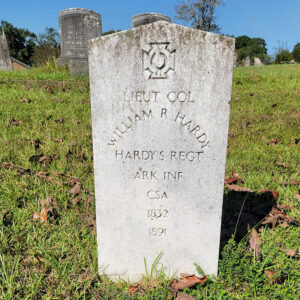calsfoundation@cals.org
Twenty-Fourth Arkansas Infantry (CS)
The Twenty-Fourth Arkansas Infantry was a Confederate unit that served in the Western and Trans-Mississippi Theaters during the American Civil War. The unit was primarily composed of men from Bradley, Calhoun, Columbia, Drew, Hempstead, Pike, Polk, Sevier, St. Francis, and Yell counties. It was organized on June 6, 1862, at Camp White Sulphur Springs in Jefferson County, and the original field officers of the regiment were Colonel E. E. Portlock, Lieutenant Colonel T. M Whittington, and Major William R. Hardy.
Assigned to Robert Garland’s brigade in September 1862, the Twenty-Fourth and its sister regiments were responsible for defense of Fort Hindman at Arkansas Post to prevent any enemy invasion by land. Later, a portion of the Twenty-Fourth was ordered to St. Charles (Arkansas County) to assist with mounting cannon to resist enemy naval advances up the White River. On January 11, 1863, the Union launched a dual naval and land assault on Arkansas Post and succeeded in capturing the entire Confederate force, including over 360 men of the Twenty-Fourth. Those men absent at St. Charles and elsewhere were eventually consolidated with members of the Nineteenth (Dawson’s) Arkansas Infantry and Lieutenant Colonel William Crawford’s Arkansas Infantry Battalion, which had also escaped capture. This portion of the Twenty-Fourth served the remainder of the war in the Trans-Mississippi Theater as the Nineteenth and Twenty-Fourth Arkansas Infantry, Consolidated, under the command of William Hardy.
Those captured at Arkansas Post were sent to Camp Douglas, Illinois, as prisoners of war and were exchanged on April 10, 1863 at City Point, Virginia. Due to General Ulysses S. Grant’s unwillingness to transfer the men back to Arkansas, the 320 survivors of the Twenty-Fourth reported to the Army of Tennessee. Assigned to various brigades over the next few months in Patrick Cleburne’s Division of Hardee’s Corps, they were consolidated with the Arkansas Post survivors of the Nineteenth (Dawson’s) Arkansas Infantry in September 1863. As part of Brigadier General James Deshler’s Brigade of Cleburne’s Division, the consolidated regiment participated in the bloody two-day Battle of Chickamauga in Georgia on September 19–20, losing thirty-eight percent of its members as casualties.
Afterward, the Twenty-Fourth was consolidated with the Second and Fifteenth (Josey’s) Arkansas regiments of Daniel Chevilette Govan’s Arkansas brigade and participated in the siege and Battle of Chattanooga, Tennessee, Battles of Missionary Ridge/Lookout Mountain, and the Battle of Ringgold Gap, Georgia. Here, as part of Cleburne’s Division and rear guard of the army, men of the Twenty-Fourth assisted in saving the entire Confederate army from destruction during its retreat.
After wintering in northern Georgia, Govan’s Brigade underwent reorganization that permanently consolidated the Twenty-Fourth and Second Arkansas under command of the Second’s Colonel E. Warfield. When General William T. Sherman began his advance on Atlanta, Georgia, in May, the Second/Twenty-Fourth fought constant battles only to fall back, in the face of overwhelming numbers, toward Atlanta. The Second/Twenty-Fourth fought in the Battles of Dalton, Dug Gap, Resaca, New Hope Church, Pickett’s Mill, and Kennesaw Mountain from May to June 1864. In July, they participated in the bloody assaults ordered by General John B. Hood in an attempt to defeat Union forces before they surrounded the city with their superior numbers. Fighting the bloody Battle of Peachtree Creek on July 20, the Second/Twenty-Fourth fought again on July 22 on the outskirts of Atlanta. After being temporarily captured, attempting to accept the enemy’s surrender, they were rescued by other units of Govan’s Brigade. During the battle, the consolidated regiment lost thirteen killed, eighty-two wounded, and twenty-five captured. This left only sixty-seven still in the ranks the following day. As Sherman’s forces continued to outflank and move south of Atlanta, the Second/Twenty-Fourth Arkansas, as part of Govan’s Brigade and Cleburne’s Division, again faced overwhelming numbers at Jonesboro, Georgia. On September 1, failing to hold, most of the brigade was captured. However, it was released within a month in a prisoner exchange and returned to duty.
The Second/Twenty-Fourth next participated in Hood’s disastrous Franklin-Nashville campaign. Due to heavy losses during the Atlanta battles, the Second/Twenty-Fourth was consolidated with the First/Fifteenth, and Fifth/Thirteenth into one regiment numbering just 300 soldiers. On November 30, 1864, Govan’s Brigade and the Army of Tennessee, charged the works at Franklin, Tennessee. Here, the consolidated Arkansas regiment lost sixty-six percent of its men as casualties. Following the retreating Union forces, the remnant fought the bitterly cold, two-day battle of Nashville on December 15–16, resulting in a devastating defeat and rapid retreat into northern Alabama.
The remnant of the Twenty-Fourth participated in the final campaign of the Army of Tennessee in North Carolina. On March 19–21, the last offensive attack by any Confederate force occurred at Bentonville, North Carolina. Although it resulted in a Confederate victory, the Army of Tennessee retreated afterward due to overwhelming reinforcements brought against it. In April, due to the extreme losses of 1864, all Arkansas regiments were consolidated into the First Arkansas Consolidated Infantry Regiment. The survivors of the Twenty-Fourth Arkansas, as part of the consolidated regiment, surrendered on April 26, 1865, with the remainder of the Army of Tennessee in Greensboro, North Carolina.
For additional information:
Connelly, Thomas L., and James Lee McDonough. Five Tragic Hours: The Battle of Franklin. Knoxville: University of Tennessee Press, 1983.
Davis, Stephen. All the Fighting They Want: The Atlanta Campaign from Peachtree Creek to the City’s Surrender, July 18–September 2, 1864. Havertown, PA: Savas Beatie, 2016.
Sessums, Danny. A Force to Be Reckoned With (The History of Granbury’s Texas Infantry Brigade, 1861–1865). Vol. 1. Murchison, TX: Cactus Rose Press, 2017.
Woodworth, Steven E., and Grady McWhiney. A Deep Steady Thunder: The Battle of Chickamauga. Abilene, TX: McWhiney Foundation Press, 1998.
Anthony Rushing
Bryant Public Schools
 Civil War through Reconstruction, 1861 through 1874
Civil War through Reconstruction, 1861 through 1874 Military
Military Hardy Grave
Hardy Grave 




Comments
No comments on this entry yet.